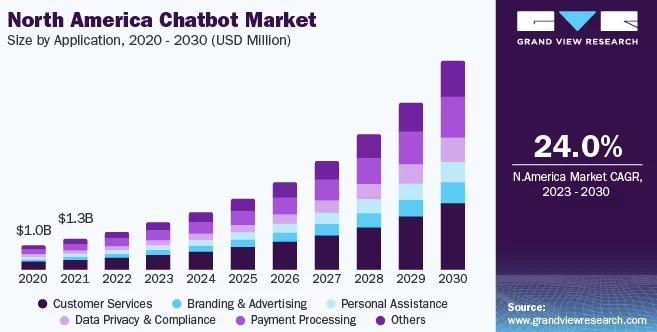The Role of Conversation Flows
2024-10-04 • Mariusz Jażdżyk
The AI market is expanding at a remarkable pace. According to a report by Grand View Research, the chatbot automation segment—including customer service, branding, personal assistants, and process automation—is projected to grow by 24% annually, reaching billion-dollar valuations by 2030.

"Gadget-Type" Solutions
In the beginning, the development of chatbots was met with great enthusiasm. The ability to have conversations with historical figures like Napoleon, via platforms such as character.ai, seemed fascinating. However, the excitement of such interactions fades quickly. These types of solutions, although they may attract users and secure rounds of funding, often function as gadgets. If they fail to find a necessary business function, their popularity declines. Their downfall is usually spectacular – and many of these "collapses" are still ahead of us, especially when we recall Peter Thiel's words about the current stage of the cycle we're in.
Challenges for Startups
Innovative solutions are continuously evolving, and many technology providers attract pioneering startups with freemium access to their platforms. However, this access often leads to a challenge: these providers may replicate the solutions developed by startups, disseminating them widely and reducing the startups' temporary competitive edge.
We encountered a similar issue ourselves a year ago. Just a month after launching Chat GPT service, we received a grant that granted us full access to their resources. During that period, we developed mechanisms that later became known as RAG (Retrieval-Augmented Generation). These solutions were also being developed in parallel by hundreds of other developers, making their emergence on the market both expected and inevitable. Today, the use of vector databases and RAG mechanisms has become a standard practice adopted by many companies.
Conversation Flows
While we have previously discussed the importance of personalization , today I’d like to focus on another crucial aspect we’ve been developing: aligning AI interactions with structured conversation flows. Many RAG-based solutions are effective at delivering carefully curated company knowledge to users, but this is not always the most critical factor. Effective user interactions require addressing various phases, such as authorization, information gathering, and executing specific actions. Designing a conversation that seamlessly guides users through these stages in a coherent and logical sequence remains a significant challenge for automated systems.
We’re proud that our product—Personal Advisor—offers a distinctive combination of personalization, the ability to tap into company knowledge via automatic connectors to popular corporate sources, the option to choose the consultant's persona, and, most importantly, executing conversations according to a well-structured, variant-based flow. While these features are still unique in the market, they are likely to become a standard practice in the years ahead.
Author: Mariusz Jażdżyk